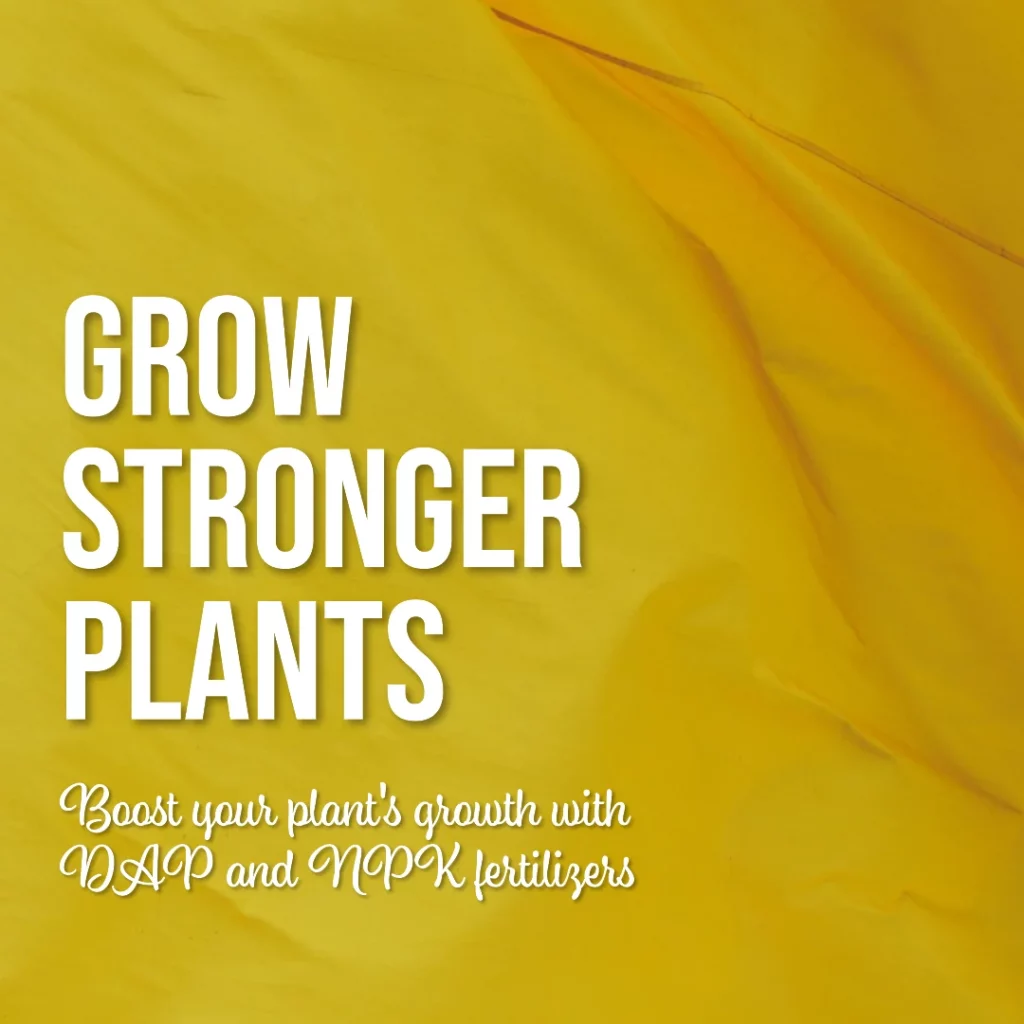What is Difference Between DAP and NPK Fertilizer

Are you confused about the differences between DAP and NPK fertilizers? Fertilizers play a vital role in modern agriculture, providing essential nutrients to support crop growth and maximize yields.
Among the various types of fertilizers, DAP (diammonium phosphate) and NPK (nitrogen, phosphorus, and potassium) fertilizers are widely use.
DAP is primarily composed of ammonium phosphate, which contains high levels of nitrogen and phosphorus. NPK fertilizers are a blend of three primary nutrients: nitrogen, phosphorus, and potassium.
While both are design to enhance plant nutrition, they differ in composition, nutrient content, and application methods.
Here is a table of the differences between Both DAP fertiliser and NPK fertiliser:
| Feature | DAP | NPK |
|---|---|---|
| Chemical formula | (NH4)2HPO4 | (NH4)2PO4·KH2PO4 |
| Nitrogen content (%) | 18 | Varies |
| Phosphorus content (%) | 46 | Varies |
| Potassium content (%) | 0 | Varies |
| Use | For crops that require high levels of phosphorus | For crops that require all three primary nutrients |
| Benefits | Provides a quick boost of phosphorus to crops | Provides a balanced supply of nutrients to crops |
| Drawbacks | Can be corrosive to metal containers | Can be less effective in alkaline soils |
So, let’s dive in and discover the fascinating differences between DAP and NPK fertilizers!
What is DAP Fertilizer?

DAP fertilizer, standing for diammonium phosphate, is recognized as one of the most common phosphorus fertilizers worldwide.
Its chemical composition, (NH4)2HPO4 or diammonium hydrogen phosphate, reflects its significance as a source of nitrogen and phosphorus. With its water soluble ammonium phosphate properties, DAP fertilizer efficiently supplies crops with these essential nutrients.
Notably, it is crucial to note that DAP fertilizer does not contain potassium, distinguishing it from NPK fertilizers.
Here’s what you need to know about DAP:
Composition:
- DAP fertilizer is a solid granular substance that appears in the form of small, light-brown or grayish-white granules.
- It typically consists of approximately 18% nitrogen (N) and 46% phosphorus pentoxide (P2O5).
Key Benefits of DAP Fertilizer:
- DAP provides readily available nitrogen and phosphorus, two essential nutrients for plant growth and development.
- It promotes root development, enhances flowering and fruiting, and improves overall plant health.
- DAP is particularly beneficial for crops that require high phosphorus levels, such as root vegetables, fruits, and legumes.
Production Process of DAP Fertilizer:
To manufacture DAP fertilizer, a meticulous process involving phosphoric acid and ammonia is implemented. The reaction between phosphoric acid and ammonia leads to the formation of a hot slurry, which is subsequently cooled, granulated, and sieved to obtain the fertilizer suitable for agricultural purposes. It is imperative to carry out this reaction under controlled conditions due to the involvement of sulfuric acid, which poses potential hazards. The standard nutrient grade of DAP fertilizer is represented by the ratio 18-46-0, signifying the nitrogen-to-phosphorus ratio, with no potassium present.

Production Steps:
- Reaction: Phosphoric acid reacts with ammonia to form a hot slurry.
- Cooling: The hot slurry is cool to allow the formation of granules.
- Granulation: The cooled slurry is transform into granules of suitable size.
- Sieving: The granules are sieve to obtain uniform particles suitable for agricultural use.
What is NPK Fertilizer?

NPK fertilizer, on the other hand, is a blend of three primary nutrients: nitrogen (N), phosphorus (P), and potassium (K). These nutrients are essential for plants and are require in varying quantities throughout their growth stages.
- Nitrogen (N): This essential nutrient is responsible for promoting leaf and stem growth and enhancing overall plant vigor.
- Phosphorus (P): Phosphorus plays a crucial role in root development, flowering, and fruit production.
- Potassium (K): Potassium is involve in enhancing plant metabolism, disease resistance, and water uptake efficiency.
Let’s explore the characteristics of NPK fertilizer:
Composition:
- NPK fertilizer is available in different formulations, each made by a set of three numbers, such as 10-10-10 or 20-10-5.
- The numbers represent the percentage by weight of nitrogen (N), phosphorus (P), and potassium (K), respectively.
Key Benefits of NPK Fertilizer:

- It provides a balance combination of essential nutrients for plants.
- The nitrogen component promotes leaf and stem growth, the phosphorus component supports root development, and the potassium component enhances overall plant vigor and resistance to stress.
- NPK fertilizers are versatile and can be tailor to meet the specific nutrient requirements of different plants and crops.
Production Process

The production of NPK fertilizer involves a systematic process to ensure the proper blending and formulation of the three essential nutrients. The following steps outline the production process:
Production Step:
- Raw Material Selection: The first step involves carefully selecting the appropriate raw materials that contain the necessary amounts of nitrogen, phosphorus, and potassium. These raw materials can include ammonium nitrate, urea, ammonium phosphate, and potassium chloride.
- Grinding and Mixing: The selected raw materials are then ground into fine particles to facilitate better blending. The finely ground materials are thoroughly mixe to ensure a homogeneous distribution of nutrients.
- Granulation: The blended mixture is passe through a granulation process, where the particles are transforme into granules of a specific size. This process helps improve the handling and application properties of the fertilizer.
- Drying: The granules are then drie to remove excess moisture, making them more stable and suitable for storage and transportation.
- Cooling: After drying, the granules go through a cooling process to stabilize their temperature and prevent clumping or caking.
- Screening and Packaging: The coole and dried granules are screene to remove any oversized or undersized particles. The final product is then package into bags or other suitable containers for distribution.
Difference between dap and npk
| Aspect | DAP Fertilizer | NPK Fertilizer |
|---|---|---|
| Composition | Ammonium phosphate | Blend of nitrogen, phosphorus, and potassium |
| Nutrient Content | High in nitrogen (N) and phosphorus (P) | Balanced combination of nitrogen (N), phosphorus (P), and potassium (K) |
| Primary Use | Promotes root development, flowering, and fruiting | Supports overall plant growth and development |
| Application Methods | Can be applied during planting or as a top dressing | Applied through broadcasting, side-dressing, or fertigation |
| Nutrient Ratios | High phosphorus content | Varies depending on the specific formulation (e.g., 10-10-10, 20-10-5) |
| Target Crops | Suitable for crops requiring a phosphorus boost, such as root vegetables and flowering plants | Suitable for a wide range of crops |
| Environmental Impact | Excessive use may lead to phosphorus runoff and water pollution | Proper application can minimize the risk of nutrient runoff |
| Cost | Relatively more expensive compared to NPK fertilizers | Cost varies depending on the specific formulation and brand |
| Availability | Widely available in agricultural supply stores | Widely available in agricultural supply stores |
| Limitations | Overapplication may result in phosphorus buildup and soil imbalances | Improper use can lead to nutrient imbalances and environmental issues |
Now that we understand the basic characteristics of DAP and NPK fertilizers, let’s compare them side by side:

- Nutrient Ratios:
- DAP fertilizer has a high nitrogen-to-phosphorus ratio (18-46-0), making it ideal for plants that demand more phosphorus, such as flowering and fruiting crops.
- NPK fertilizers offer a range of nutrient ratios, allowing growers to select the formulation that best suits their specific plant requirements.
- Nutrient Availability:
- DAP fertilizer releases its nutrients relatively quickly upon application, providing an immediate boost to plant growth.
- NPK fertilizers can have varying release rates, depending on the specific formulation and coating technology used. Slow-release NPK fertilizers provide a gradual nutrient supply over an extended period.
- Application Considerations:
- DAP fertilizer is commonly use as a basal application during planting or as a top-dressing fertilizer.
- NPK fertilizers can be applie as basal, top-dressing, or foliar sprays, depending on the crop and growth stage.
Conclusion dap vs npk:
In conclusion, DAP and NPK fertilizers are both valuable tools in the world of agriculture and gardening. DAP, with its high phosphorus content, is excellent for crops that require substantial phosphorus supplementation, while NPK fertilizers provide a balanced blend of essential nutrients. By understanding the differences between DAP and NPK, you can choose the right fertilizer for your specific plant needs and optimize their growth and productivity.
Remember, fertilizers are just one piece of the puzzle when it comes to successful plant cultivation. Soil quality, proper watering, and other cultural practices also play crucial roles. Happy gardening, and may your plants thrive with the nourishment they need!







